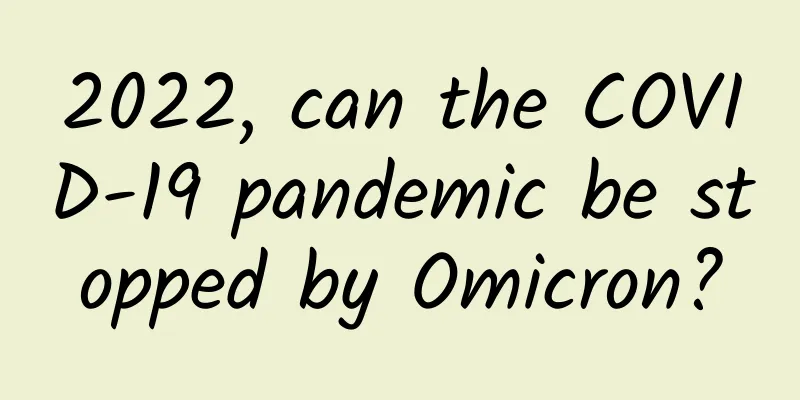2022, can the COVID-19 pandemic be stopped by Omicron?

|
Although the decline of the COVID-19 pandemic has not yet been seen, early data points in that direction. Written by | Xiaoye Omicron is the 15th letter of the Greek alphabet. At the end of 2021, "Omicron" was named after the latest variant of the novel coronavirus that spread around the world, making the two-year-long COVID-19 pandemic even worse. From South Africa to the world On November 9, 2021, the southern African country of Botswana detected a new coronavirus variant B.1.1.529 for the first time in a laboratory-confirmed case. Two days later, three confirmed cases appeared immediately. South Africa followed closely and detected exactly the same variant in 77 virus samples collected in Gauteng Province from November 12 to 20. On November 24, South Africa reported B.1.1.529 to the World Health Organization for the first time. Based on the opinions of the Technical Expert Group on the Evolution of the Novel Coronavirus, the WHO officially listed it as the fifth variant of concern (VOC) after the Delta variant, named Omicron, and sounded the alarm for global spread. It is worth mentioning here that although Omicron was originally discovered in African countries, it is not certain that its origin is Africa. [1-3] Having experienced the power of the Delta variant, many countries immediately adopted travel restrictions. The United Kingdom, the United States, Australia and other countries first banned travelers from southern Africa. However, some health experts believe that the lifting of restrictions in European and American countries and the resumption of international travel have provided a window for the spread of the virus, and the effect of restricting travel again at this time may not be ideal. [4] As expected, on November 26, Belgium announced the discovery of the first confirmed case of Omicron, and subsequently traces of Omicron appeared in many European countries. The UK soon fell into the "hardest hit area" after reporting the first case of Omicron infection on the 27th. The European Center for Disease Prevention and Control raised the risk assessment of this new variant to public health to a "very high" level. The President of the European Commission once worriedly said that it might only take two months for Omicron to conquer Europe during the Christmas and New Year holidays at the end of the year in Europe. Since the United States reported its first case of Omicron infection on December 1, the variant has been detected in nearly 50 states. Omicron quickly replaced the Delta variant and became the main prevalent strain in the United States. Public health experts at the University of Minnesota stressed that if explosive transmission occurs simultaneously in many parts of the world, it will inevitably put greater pressure on global supply chains and medical resources. [5] Figure 1. The model predicted that the Omicron variant may become the most prevalent coronavirus variant in the United States. Source: STATnews In my country, as early as mid-November 2021, when our knowledge of Omicron was still limited to South Africa, a case of infection directly related to travel to South Africa appeared in Hong Kong, China. Since mid-December, Tianjin (1 case), Guangzhou, Guangdong Province (1 case) and Changsha, Hunan Province (2 cases) have successively announced confirmed cases of Omicron infection. [6, 7] In summary, according to statistics from the World Health Organization, within just one month since its discovery, the omicron variant has rapidly spread to more than 80 countries and regions around the world outside Antarctica. Figure 2. The WHO weekly report on the COVID-19 epidemic on December 21, 2021, marked the global spread of the Omicron variant based on the data at the time. Source: WHO[8] Omicron's Secret Weapon Mutation after mutation On November 27, 2021, a research team at the Ospedale Pediatrico Bambino Gesu in Rome, Italy, released the first 3D structure of the Omicron variant [9]. Compared with Delta, Omicron's spike protein has more mutations, almost twice as many as the former, and most of these mutations are located in the area where the virus interacts with human cells. The UK Health and Safety Agency’s “UK Coronavirus Variants of Concern Survey Report”[10] released on November 26 listed all the genetic mutations carried by Omicron (Figure 3), of which a total of 32 mutations appeared on the spike protein that binds to the human cell surface receptor. These mutations can change the characteristics of the virus invading human cells, thereby affecting the protective efficacy provided by vaccines and neutralizing antibodies. For example, Omicron has the N501Y mutation shared by the Alpha and Beta variants. This mutation can enhance the ability of the spike protein to bind to the human receptor ACE2; it also has a mutation at position E484 of the spike protein receptor binding domain (RBD), which can escape the recognition of the RBD by neutralizing antibodies. In addition, the P681H and N679K mutations are located near the furin cleavage site of the spike protein. This site helps the virus enter respiratory epithelial cells. Mutations near it make the spike protein easier to be cleaved, thereby enhancing the virus's ability to infect. The Delta strain, which previously had an advantage in transmission, carries the P681H mutation, which may be one of the reasons for its enhanced transmission ability. [11] Figure 3. Using the wild-type coronavirus strain as a reference, the mutation sites of the Delta (left) and Omicron (right) variants. Image source: Rome Children's Hospital/ANSA The latest analysis recently published in the journal Signal transduction and targeted therapy also pointed out [12] that other new mutations in the RBD of the Omicron variant and the 12 mutations contained in the receptor binding motif (438aa-508aa) may cause a huge change in the viral conformation, thereby increasing the ability to evade immunity. However, to further analyze the interaction mechanism between the variant RBD and ACE2, we still need more structural biology research. How fast does Omicron spread? South Africa and the UK, which are both hit by Omicron outbreaks, can provide us with some useful information. As mentioned above, the Gauteng Province of South Africa reported confirmed cases of the new variant as early as early November 2021. All data collected as of December 7 showed that the number of Omicron cases showed an exponential growth trend within four weeks, with a doubling time of only 3.38 days. The results of genetic sequencing of cases on December 9 showed that Omicron accounted for 70% of all cases in Gauteng Province. If the Rt value (effective reproductive number) commonly used in epidemiology is used to evaluate the epidemic, the Rt value in Gauteng Province at the end of November was obviously more than 2, indicating that Omicron is more contagious than the Delta variant. Tom Wenseleers, an evolutionary biologist at the University of Leuven in Belgium, said that in the same period of time, the number of people infected with Omicron is expected to be 3 to 6 times that of Delta. [13] Epidemiological data obtained from South Africa confirmed the strong transmission ability of Omicron - it accounted for about 90% of the total daily sequencing volume within 25 days after the outbreak; and the Beta variant accounted for about 50% of the total daily sequencing volume around 100 days after the outbreak. In the same period of time, the proportion of the Delta variant was about 80% [14]. In the northern hemisphere, on November 27, 2021, the UK reported its first case of Omicron infection. As of December 17, the number of newly confirmed cases in the UK had exceeded 10,000 per day. After observing the family transmission of 121 Omicron-infected people, researchers found that the possibility of infection between family members was about three times that of the Delta strain, and the possibility of infection among close contacts was twice that of Delta. British scientists estimate that the Rt value of Omicron has risen to 3-5, while the Rt value of Delta is 1.1-1.2. Why is this? Neil Ferguson, an epidemiologist at Imperial College London, speculated that from the perspective of the virus itself, Omicron has both high transmission and high infection capabilities, and coupled with the ability to evade vaccines or immunity acquired through natural infection, its transmission capability is far ahead. In addition, the population concentration created by Christmas also gave Omicron an opportunity to take advantage. [15] Omicron has a stronger ability to spread among the population than other variants; in the human body, studies have shown that, especially in bronchial tissue, Omicron infects and replicates 70 times faster than the Delta strain. At the same time, in lung tissue, Omicron's replication ability is 10 times lower than that of the original virus strain, indicating that its pathogenicity may be weaker [16]. However, this study has a limitation. The lung and bronchial tissues used are not perfect models for investigating the specific conditions of in vivo exposure to the virus, because the in vitro model has not yet taken into account the immune response or the role of the vaccine. Despite this, the study still provides rich information [17]. There are more mild cases than severe ones. Although Omicron's "blitzkrieg" successfully conquered six continents around the world, the news does not seem to be too bad in terms of the impact on the extent of the disease. In South Africa, a month after the Omicron outbreak, hospitalizations for severe COVID-19 patients increased slightly, and there were early signs that Omicron might not be as likely to cause severe illness as other strains. A report released in late November 2021 supports this relatively optimistic view[18]: The author, Fareed Abdullah, director of the Office of HIV and TB Research at the South African Medical Research Council, reviewed the conditions of 42 COVID-19 patients hospitalized a week earlier and found that only 13 of them required supplemental oxygen, and four of them were receiving oxygen for reasons unrelated to COVID-19. Only one of these 42 patients was in the intensive care unit, and the trend in the distribution of disease severity was consistent with data released by the National Institute of Communicable Diseases in the United States at the same time: despite the surge in the number of infections (for example, nearly 10,000 new cases in just five days from November 29 to December 3), only 106 patients had been in intensive care units in the previous two weeks. However, we still need to be cautious about Abdullah's report because the sample size of 42 people is small and the findings have not been peer-reviewed. In addition, although the government reported that the Omicron strain accounted for three-quarters of the virus samples in South Africa, Abdullah did not find out exactly how many people in the sample were infected with Omicron. Like South Africa, there are early signs in Europe that Omicron cases may be quite mild, but easy to infect. In early December 2021, the US Centers for Disease Control and Prevention published a small sample survey report on its official website [19]. Based on the situation of 43 Omicron infected people, the researchers listed the most common symptoms of the disease: cough, fatigue, congestion and runny nose (which looks very similar to the flu). On the other hand, the latest animal experiments showed that the virus levels in the nasal cavity of Syrian hamsters infected with Omicron were consistent with the levels of other strains at the beginning of infection, while the infection level in the lungs was only 10% or even lower than that of other variants. The researchers also infected the bronchial tissue of animals with Omicron and found that within the first two days after infection, Omicron developed much faster than the Delta variant or other original coronaviruses [20]. Generally speaking, coronavirus infection starts in the nose or mouth and then spreads to the throat. Mild infections usually stop here. If the coronavirus continues to penetrate the lungs, the condition will develop into a serious one. Dr. Ravindra Gupta of the University of Cambridge is one of the scientists who closely follows the Omicron variant. He speculated that "the Omicron variant is likely to evolve into an upper respiratory tract infectious disease, threatening the health of the throat and nasal cavity." [21] To ensure the authenticity of this speculation, further animal model (monkey) experiments or examination of more human infections with the new variant are needed. However, even if it turns out that the proportion of severe cases in Omicron cases is lower, this good news is offset by the fact that "more people are infected." On December 19, German medical and public health experts submitted a report to the government, pointing out that "if Omicron induces milder symptoms than other variants, the overall epidemic situation is unlikely to be catastrophic, but we still need to be careful, as hospitals may still be at risk of being overloaded." In addition, experts also warned that large-scale infection of Omicron may lead to more long-term COVID symptoms (Long COVID) [22]. Shortened incubation period? More evidence is needed. After the original novel coronavirus enters the human body, it usually has an incubation period of 5 to 6 days. Omicron spreads so quickly, has the incubation period also been shortened? So far, scientists have not had time to collect sufficient data to verify the above speculation. This is because the incubation period may be different for different people due to various factors such as immune status and personal condition; secondly, we have not yet fully understood the exact mechanism of interaction between Omicron and cells [23]. On December 10, 2021, scientists from the Norwegian Institute of Public Health published a newsletter[24], which was an epidemiological survey of 111 people who attended a party on November 26. One person at the party was confirmed to be infected with Omicron on December 13. After virus monitoring, 66 people were confirmed (through whole genome sequencing and PCR VOC screening), 15 were suspected (only positive for nucleic acid testing), and all 81 people were infected with Omicron. The researchers assumed that the contact occurred at the party. Based on the information provided by all respondents, the incubation period for symptomatic infections ranged from 0 to 8 days, with a median of 3 days (see Figure 4), that is, most people began to show symptoms on the third day after the party. Figure 4. According to the information provided by all respondents, the incubation period for symptomatic infections ranged from 0 to 8 days, with a median of 3 days. Source: Outbreak caused by the SARS-CoV-2 Omicron variant in Norway, November to December 2021 The contact-infection timeline given by the Norwegian team is still preliminary research, and the sample size is extremely limited, which may not represent the general situation beyond these 111 people. However, the 3-day incubation period seems to be consistent with the early situation in South Africa. A shorter incubation period allows the infected to be contagious faster, resulting in more infections in a shorter period of time and greater difficulty in prevention. However, we still need more relevant data to finally determine the length of Omicron's incubation period. Fighting Back Oral medication, great expectations On November 4, 2021, Molnupiravir, the world's first oral antiviral drug for COVID-19, jointly developed by US pharmaceutical companies Merck and Ridgeback Biotherapeutics, was the first to be approved by the UK Medicines and Healthcare products Regulatory Agency. On December 23, the FDA also approved the emergency use authorization for the oral drug. Soon after, on November 5, Pfizer announced the results of a Phase III clinical study of its oral COVID-19 drug Paxlovid, which provided very positive data: patients with mild to moderate COVID-19 who took the drug within three days of diagnosis could reduce their risk of hospitalization or death by about 89%. On December 22, the FDA approved the emergency use authorization of Paxlovid, but also set restrictions: the user must be at least 14 years old, weigh at least 40 kilograms, and have a positive direct test result for the new coronavirus. These patients have a higher risk of developing severe illness (such as hospitalization or death). Like Molnupiravir, Paxlovid is also a prescription drug that can be used as soon as possible after COVID-19 is confirmed and within five days of the onset of symptoms, but it does not include prevention before and after COVID-19 exposure, nor does it include the treatment of critically ill COVID-19 patients, and it cannot replace vaccines. [25, 26] For the details of these two drugs, you can read "Monapivir, the world's first oral drug against the new coronavirus, is it an angel or a devil?" and "No fear of mutation: Pfizer's new drug Paxlovid may break the shadow of the new coronavirus." Figure 5. Pharmacological mechanisms of action of two oral antiviral drugs for COVID-19. Translated by the author. Source: SCIENCE The only remaining antibody drugs In mid-December 2021, a series of preprint papers exploring Omicron’s ability to fight against monoclonal neutralizing antibody drugs were quickly published online (without peer review) [27]. Nine antibody drugs—LY-CoV016/LY-CoV555 (Abcellera, Eli Lilly and Junshi Biosciences), REGN-10933/REGN-109876 (Regeneron), AZD1061/AZD8895 (AstraZeneca), VIR-7831 (VIR and GlaxoSmithKline), BRII-196 (Taiwan Biopharma), and DXP-604 (BeiGene and Danshen Biopharma)—were tested, and the results were not optimistic: Omicron was able to completely or partially evade 85% of existing monoclonal neutralizing antibody therapies. The two drugs that have withstood the test are sotrovimab (VIR-7831), developed jointly by Vir Biotech and GlaxoSmithKline in the United States, and DXP-604, developed by BeiGene and Danshen Biopharma[28]. Researchers used live viruses or artificial "pseudoviruses" to test the efficacy of drugs and found that although the neutralizing ability of sotrovimab and DXP-604 against the Omicron variant was significantly lower than that of the Delta variant (reduced by 2.5-18 times), they still had neutralizing ability. COVID-19 vaccine booster shots Faced with the ever-mutating coronavirus, humans are constantly upgrading and transforming the weapons they have to fight back. On December 23, 2021, Nature magazine published several accelerated preview papers online, in which a team of Chinese and foreign scientists examined the effectiveness of vaccines against Omicron from different angles. Professor David Ho's team at Columbia University in the United States [29, 30] tested four vaccines that are widely used worldwide: Pfizer/BioNTech, Moderna, Johnson & Johnson, and AstraZeneca. They collected blood samples from 39 subjects who had received two doses of the vaccine (two of whom had been infected with the new coronavirus) to test their neutralizing activity against Omicron. The results showed that the neutralizing antibody titers of all 39 subjects decreased significantly, with those who received the Pfizer/BioNTech and Moderna vaccines dropping to 1/21 and 1/8.6 of the original virus strain. So, are booster shots useful? After testing the serum samples of 15 subjects who received booster shots of the Pfizer/BioNTech or Moderna vaccine, it was found that although the neutralizing antibodies of these people also decreased, the decrease was slightly smaller than that of those who received two shots of the vaccine. Therefore, the researchers cautiously stated that even if a booster shot is given, there is still a possible risk of infection with the Omicron variant. Scientists at the Pasteur Institute in France[31] also found that five months after two doses of the vaccine (Pfizer/BioNTech or AstraZeneca), serum samples showed no detectable antiviral activity against Omicron. However, antibodies in serum from individuals who received a third booster dose and two more doses of the vaccine after infection were still able to neutralize Omicron, although the antibody titers against Omicron were 6 to 23 times lower than those against Delta. This result coincides with the preliminary laboratory research data jointly released by Pfizer/BioNTech in early December. However, some authorities believe that the decline in neutralizing antibodies does not completely mean that the effectiveness of vaccines has declined. Soumya Swaminathan, chief scientist of the World Health Organization, said that the human immune system has T cells and memory B cells. It is still too early to conclude that the effectiveness of vaccines has significantly declined based on the decrease in neutralizing antibodies. We still need more time and data to determine the correlation between the two aspects. At present, there is a unanimous consensus both at home and abroad that in the face of new mutant strains, two doses of vaccination can no longer provide sufficient protection, and it is urgent to fully vaccinate with booster shots as soon as possible. On December 23, my country's National Center for Infectious Diseases (Zhang Wenhong's research team at Huashan Hospital Affiliated to Fudan University) and the Shanghai Key Laboratory of Infectious Diseases and Biosafety Emergency Response officially published the results of China's first peer-reviewed vaccine booster vaccination on Omicron immunity in Emerging Microbes & Infections. The team evaluated the neutralizing ability of the sera of subjects vaccinated with two doses of inactivated vaccine, subjects with a third homologous booster, and subjects with a third recombinant protein vaccine heterologous booster against Omicron for the first time in the world. The results showed that "14 days after the third homologous booster of the inactivated vaccine, the neutralizing antibody titers against the original virus strain of the vaccine, the Delta variant, and the Omicron variant in the serum increased to 285.6, 250.8, and 48.73, respectively. If the third heterologous booster of the recombinant subunit protein vaccine is used for 14 days, the neutralizing antibody titers against the original strain, the Delta strain, and the Omicron strain in the serum will increase to 1436, 1501, respectively. and 95.86. Regardless of the type of third booster, the positive rate of neutralizing antibody titers against the Omicron strain in serum samples reached 100%. This means that the three-shot booster strategy can provide a certain degree of protection, but there are also differences in the level of antibodies. These studies have confirmed that based on two shots of inactivated vaccine, the third shot of homologous and heterologous boosters increased the body's neutralizing ability against the Omicron strain by 8.07 times and 15.87 times, respectively. At the same time, the neutralizing antibody titers against the original vaccine strain also increased by 4.24 times and 21.31 times. "[32] Therefore, in view of the current situation, Zhang Wenhong’s research team summarized three key directions and possible risks for future epidemic prevention[32]: “Vaccine boosters can improve the immune barrier, but they cannot completely block the spread of Omicron. "Currently, strengthening public health and social measures (PHSM) and booster vaccination with a third dose of vaccine are the best strategies for the world to form a herd-level protection barrier against the Omicron variant. "If the virus mutates further in the future, we may adopt a prevention and control strategy similar to influenza virus vaccination, increasing the frequency of vaccination to deal with the mutation of the virus." 2021 has passed, and the Omicron variant has accompanied humans into the new year. Although it has only been more than a month since we discovered and named it, scientists have already gained a preliminary understanding of it from various aspects such as biological properties, pathology, immunology and epidemiology. These basic data and conclusions point out the direction for our work in the fight against the epidemic in the new year. Experiments on animals and human tissues have shown that Omicron has evolved into an upper respiratory tract infectious disease, mainly infecting the nasal cavity, throat and trachea. Its spike protein has lost the ability to be activated by a cell surface protease, making it difficult to invade lung cells. The new coronavirus is following in the footsteps of several other coronaviruses and gradually evolving into a highly contagious and low-toxic upper respiratory tract infectious disease. This is also in line with the general law of viral evolution. Despite this, we should still take active precautions and enjoy the Spring Festival. For specific methods, please refer to "WHO Recommendations: How to Care for Suspected COVID-19 Infections at Home? Attached is the Correct Way to Sneeze and Wash Hands | Touching the Elephant" and "Which Disinfectant is Effective Against Coronavirus? | 117 Three People" References [1] https://mp.weixin.qq.com/s/jBK_RkIFWGPzwIuiESdtOQ [2] https://www.thepaper.cn/newsDetail_forward_15549076_1 [3] https://mp.weixin.qq.com/s?__biz=MzAwNTAyMDY0MQ==&mid=2652631239&idx=1&sn=75b6496dc61645a584974753dcd4445c&chksm=80cc 5e49b7bbd75f6e91a87c5e7ab8bfa1ef6b67b57995cd78c5dbf98179e7d4437073091019&scene=178&cur_album_id=1676900387171123202#rd [4] https://www.thepaper.cn/newsDetail_forward_15565379_1 [5] https://www.statnews.com/2021/12/21/omicron-by-the-numbers-where-things-stand-now/ [6] https://mp.weixin.qq.com/s/FOl6Qb7avaj9gvXSnfYFVQ [7] https://mp.weixin.qq.com/s/yWeAT2oLx9a9yDbI65C-Fg [8] https://www.who.int/publications/m/item/weekly-epidemiological-update-on-covid-19---21-december-2021 [9] https://www.msn.com/en-us/travel/news/first-image-of-omicron-shows-many-more-mutations-than-delta/ar-AARegFe?pfr=1#image=1 [10] https://assets.publishing.service.gov.uk/government/uploads/system/uploads/attachment_data/file/1036501/Technical_Briefing_29_published_26_November_2021.pdf [11] https://assets.publishing.service.gov.uk/government/uploads/system/uploads/attachment_data/file/1036501/Technical_Briefing_29_published_26_November_2021.pdf [12] https://www.nature.com/articles/s41392-021-00852-5 [13] https://mp.weixin.qq.com/s?__biz=MzAwNTAyMDY0MQ==&mid=2652632213&idx=1&sn=bd5e 2f273deb79635f398b077ef27a58&chksm=80cc5a1bb7bbd30d2804f2803bf34768bf873eb951e 5f4e24246a015651f576a305c574d094&scene=178&cur_album_id=1676900387171123202#rd [14] https://mp.weixin.qq.com/s/prbqV4JT7MUzcrbAQVDGqQ [15] https://www.thepaper.cn/newsDetail_forward_15853534_1 [16] http://www.med.hku.hk/zh-hk/news/press/20211215-omicron-sars-cov-2-infection [17] https://www.the-scientist.com/news-opinion/omicron-propagates-70-times-faster-than-delta-in-bronchi-study-69540 [18] https://www.samrc.ac.za/news/tshwane-district-omicron-variant-patient-profile-early-features [19] https://www.cdc.gov/mmwr/volumes/70/wr/mm7050e1.htm?s_cid=mm7050e1_w [20] https://www.researchsquare.com/article/rs-1211792/v1 [21] https://www.nytimes.com/2021/12/31/health/covid-omicron-lung-cells.html [22] https://www.science.org/content/article/early-lab-studies-hint-omicron-may-be-milder-most-scientists-reserve-judgment [23] https://www.theatlantic.com/science/archive/2021/12/omicron-incubation-period-testing/621066/ [24] https://www.eurosurveillance.org/content/10.2807/1560-7917.ES.2021.26.50.2101147 [25] https://mp.weixin.qq.com/s/97C1YzFD_lfP9VMB3qZG6A [26] https://www.fda.gov/news-events/press-announcements/coronavirus-covid-19-update-fda-authorizes-first-oral-antiviral-treatment-covid-19 [27] https://www.nature.com/articles/d41586-021-03829-0#ref-CR3 [28] https://www.biorxiv.org/content/10.1101/2021.12.07.470392v2 [29] https://media.nature.com/original/magazine-assets/d41586-021-03826-3/d41586-021-03826-3.pdf [30] https://www.nature.com/articles/d41586-021-03826-3 [31] https://www.nature.com/articles/d41586-021-03827-2 [32] https://mp.weixin.qq.com/s/zdSi6YWgi2V_0Axw6201oQ |
Recommend
Why does influencer marketing need the support of paid advertising?
In recent years, influencer marketing has grown f...
360 secure routing experience: more than just improving security
With the popularity of Wi-Fi devices such as lapto...
Douban's ten years: 100 million young artists come together to form a style
Over the past decade, China's impetuous Inter...
The Wentian experimental cabin has been relocated, and here come the hard-core knowledge points!
At 12:44 on September 30, after about an hour of ...
20 tips for hot-selling headlines!
Besides the content, the most important thing abo...
How to use Zhihu to divert private domain traffic?
In this era of prevalence of self-media and unive...
Addicted to cats? The reason why cats are so popular is →
It is said that "it is fun to pet cats, and ...
A Douyin video makes a brand popular! How to use information flow to achieve wild growth?
Growing up is often painful, but learning smartly...
SEM training account structure building process!
Almost every day, someone posts messages in the b...
Practical knowledge on field marketing gained through spending hundreds of thousands of dollars in practice!
Startup companies have few resources, a shortage ...
How much does it cost to wish an African a happy birthday? How much do African birthday wishes cost?
A simple small blackboard with words written on i...
These 20 popular topics generate multiple articles with more than 100,000 views every year.
One of the most important and difficult tasks for...
IDC: Enterprise AI spending will exceed $30 billion in 2027
IDC’s recent forecast suggests that by 2027, ente...
Tips for writing titles for new media operations!
One of the basic skills of new media operation is...
Community operation methodology: how to gather target users
In early 2015, communities began to become popula...









